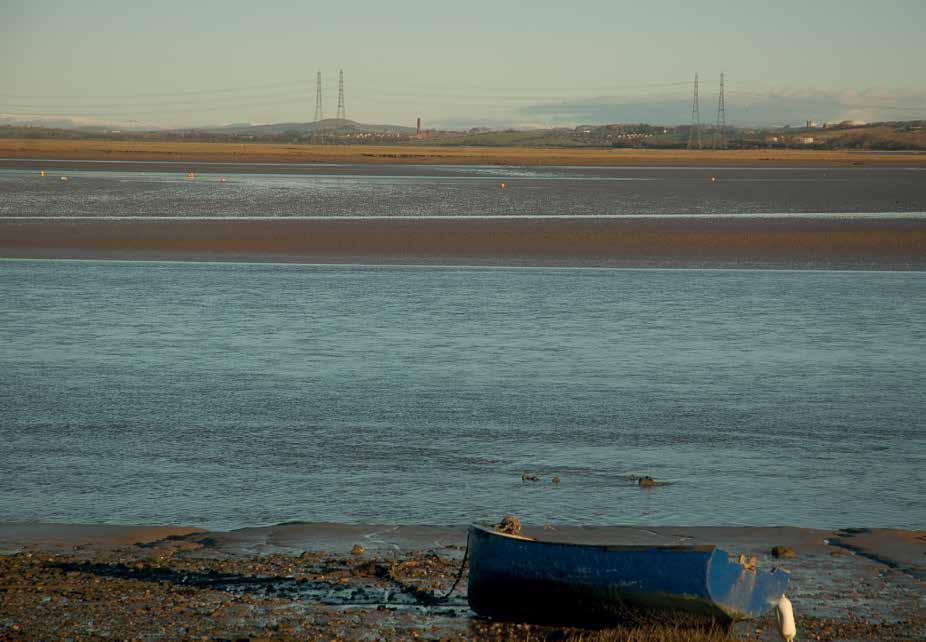
6 minute read
HOW NATURAL ENGLAND USE
Your counts count
The wealth of bird data provided by WeBS volunteers are used daily by Natural England’s conservation advisors and ornithologists for a wide range of purposes.
Allan Drewitt Senior Ornithologist, Natural England
DETAILED DATA... Conservation advice is available via the Designated Sites System search page at https://designatedsites. naturalengland.org.uk/ SiteSearch.aspx
WeBS data are particularly valued for managing protected wildlife sites important for birds: Sites of Special Scientific Interest (SSSIs), Special Protections Areas (SPAs) and Ramsar Sites. We use both Core Count and Low Tide data to help support the case for nature conservation designations for birds; to set conservation objective targets; to monitor and assess site condition against these targets; and to assess the potential impacts of built development and other activities on these sites. Data collected away from protected sites are similarly of value in that they contribute to our understanding of regional and national population trends, identify potential new protected sites and help to locate and count SSSI and SPA birds which periodically feed or roost outside protected site boundaries.
WeBS DATA UNDERPIN PROTECTED SITE DESIGNATIONS
The most obvious and perhaps rewarding application of WeBS data is the designation of new SSSIs, SPAs and Ramsar Sites. Recent examples of major site designations are the combination of two SPAs to create the new Morecambe Bay and Duddon Estuary SPA/Ramsar Site and the extension of the Teesmouth and Cleveland Coast SPA/Ramsar Site, both including additional areas of habitat important for coastal nonbreeding and breeding birds. These new sites protect habitat used by a combined total of nearly 30,000 waterbirds and seabirds, including
WeBS data were valuable for the designation of Morecambe Bay and Duddon Estuary SPA
new species as ‘qualifying features’ such as Ruff and Mediterranean Gull. Proposals to designate new protected sites are subject to public consultation and the highest level of scrutiny before receiving Ministerial approval. As such, very few designations would have succeeded without the evidence provided by WeBS counts, with their proven track record of rigorous survey methodology, coordinated coverage and data validation.
WeBS DATA INFORM CONSERVATION OBJECTIVES AND TARGETS
WeBS data relating to birds which are qualifying features of protected sites are used in Natural England’s conservation advice packages. These set out our conservation objectives for SSSIs and SPAs, providing information on desired bird and habitat feature condition, including abundance targets which are often based on WeBS counts. Annual monitoring is crucial here, as we want our targets to reflect situations where numbers have consistently increased over time, and also to ensure that we take care not to make less favourable numbers worse still. WeBS provides an up to date, longrunning data series which we rely upon to review and revise our targets. Our conservation advice packages also assist environmental assessments of any proposed activity affecting sites by advising on activities that can potentially affect bird features or habitats, and therefore have potential to undermine our objectives.
WeBS DATA REFLECT SITE CONDITION
Recently we have worked with BTO to develop ways to use WeBS Alerts to help monitor the health (or ‘condition’) of sites designated for nonbreeding waterbirds. Alerts are provided for 49 species or species populations and are available for 55 SPAs across England. The latest Alerts, using data up to 2017/18, show trends and percentage changes in numbers against the ‘baseline’ values used to justify site designations. This means that we can compare the existing value of sites with their importance at the time of designation which, in many cases, is over 30 years ago.
Changes in bird numbers can reflect site-level factors, such as increased disturbance or habitat deterioration, but can equally result from wider changes outside our control such as changes in migratory bird movements, including ‘short-stopping’. Comparison with regional and national trends over the same time period will ultimately allow us to identify those sites which are in ‘unfavourable condition’ and where resources are necessary to undertake research into the causes of declines and implement necessary management changes. Sometimes this research can involve greater interrogation of the WeBS data, for example in studies of the potential disturbance effects of recreational activities on estuaries. Although bird trends are usually just one component of site health checks, which include many other attributes relating to habitat suitability, they provide the most obvious, reliable and regular indicator of change, once again underlining our reliance on WeBS.
WeBS DATA ARE CRUCIAL FOR IMPACT ASSESSMENTS
All WeBS counters will be aware of the many human activities that can influence bird numbers, including built development on or near bird habitats, industrial operations, flood defence works and a variety of recreational activities. These can result in habitat loss or deterioration, either directly through changes in land management or indirectly because of increased disturbance.
When assessing the effects of any proposed activity on protected sites the most important information is the number and distribution of birds likely to be affected, particularly those which are qualifying features. Recent bird counts at the sector level are crucial and we often compare five-year peak means for affected areas against the overall site totals to provide essential context for our advice. When considering effects of habitat loss and/or displacement on intertidal areas we also use Low Tide data as additional supporting information.
WeBS Alerts have long been used to assist such site protection casework, often providing important details on bird trends which can help understand the implications of new proposed activities and strengthen the case to oppose changes or mitigate their effects. The comparison of site-level trends with regional or national trends is often particularly revealing and helpful in these cases, and the more advanced sector-level alerts can help understand where and why sites are failing to support their bird populations.
Much of this work would be impossible without WeBS data and we would like to thank all volunteers working both on and off designated sites for their efforts. Your data are highly valued and essential for our work to protect, manage and monitor England’s internationally important waterbird populations.
GLOSSARY
Protected Sites: • Site of Special Scientific Interest (SSSI): land designated under the
Wildlife & Countryside Act 1981 for the special interest of its flora, fauna or geological or physiographical features. • Special Protection Area (SPA): strictly protected sites designated under the Birds Directive (Directive 2009/147/EC on the conservation of wild birds). • Ramsar Sites: wetlands of international importance designated under the
Ramsar Convention.
Qualifying features: the features for which a SSSI, SPA or Ramsar site has been designated. In the case of birds they normally include species present in nationally or internationally important numbers (i.e. at least 1% of GB or biogeographic populations respectively) and/or important assemblages of different species. Conservation objectives: a description of the desired state of the qualifying features of a protected site including specific targets or target ranges. Features being managed in a way which maintains their nature conservation value are in "favourable condition", meaning that the features are being adequately conserved and monitoring demonstrates that they are meeting all the mandatory site-specific targets set by the conservation objectives. Baseline values: normally the numbers of individuals of specified bird species, or numbers of individuals in an overall bird assemblage, present at the time of site designation. These figures are often provided in formal descriptions ("citations") of a site’s importance.










